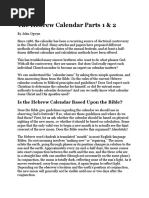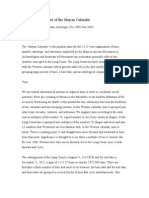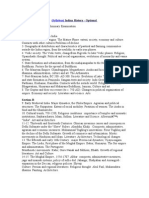Solar Calendar
Solar Calendar
Uploaded by
vstan9Copyright:
Available Formats
Solar Calendar
Solar Calendar
Uploaded by
vstan9Original Description:
Copyright
Available Formats
Share this document
Did you find this document useful?
Is this content inappropriate?
Copyright:
Available Formats
Solar Calendar
Solar Calendar
Uploaded by
vstan9Copyright:
Available Formats
Solar calendar
A solar calendar is a calendar whose dates indicate the 3 Sidereal solar calendars
position of the earth on its revolution around the sun or
equivalently the apparent position of the sun moving on Further information: Sidereal time
the celestial sphere.
If the position of the earth (see above) is reckoned with
respect to the xed stars, then the dates indicate the
zodiacal constellation near which the sun can be found.
A calendar of this type is called a sidereal solar calendar.
Astronomy
Main article: Astronomy
The mean calendar year of such a calendar approximates
the sidereal year.
The natural science of astronomy is the study of celestial
objects, observations and phenomena in the night sky.
The ancient discipline of astronomy is the key method
of calculating a date and time. A star in a solar system
is the source of light which creates the stellar day, the
rotation period of orbiting planets regulates the seasons
on a planet surface, this combination is monitored and
recorded by a calendar.
Indian calendars like the Hindu calendar, Tamil calendar, Bengali calendar and Malayalam calendar are sidereal solar calendars. The Thai solar calendar, based on
the Hindu solar calendar is also a sidereal calendar. They
are calculated on the basis of the apparent motion of the
sun through the twelve zodiacs rather than the true tropical movement of the earth.
Tropical solar calendars
4 Non-solar calendars
If the position of the earth in its orbit around the sun is
reckoned with respect to the equinox, the point at which
the orbit crosses the celestial equator, then its dates accurately indicate the seasons, that is, they are synchronized
with the declination of the sun. Such a calendar is called
a tropical solar calendar.
Calendars that are not solar calendars include the Islamic
calendar, which is a purely lunar calendar and calendars
synchronized to the synodic period of Venus or to the
heliacal risings of stars.
The duration of the mean calendar year of such a calendar approximates some form of the tropical year, usually
either the mean tropical year or the vernal equinox year.
5 Lunisolar calendars
The following are tropical solar calendars:
Lunisolar calendars may be regarded as solar calendars,
although their dates additionally indicate the moon phase.
Because a typical lunisolar calendar has a year made up
of a whole number of lunar months, it can't indicate the
position of Earth on its revolution around the sun as well
as a pure solar calendar can.
Gregorian calendar
Iranian calendar (Jalli Calendar)
Julian calendar
Coptic calendar
Every one of these calendars has a year of 365 days,
which is occasionally extended by adding an extra day
to form a leap year, a method called "intercalation", the
inserted day being intercalary.
6 See also
Analemma calendar
The Zoroastrian calendar, the earliest solar calendar, is
a religious calendar used by adherents of the Zoroastrian
faith, and is an approximation of the tropical solar calendar.
Astronomical clock
Daytime (astronomy)
1
External links
Correspondence between Hebrew and Islamic calendars, months and holidays (pdf)
EXTERNAL LINKS
Text and image sources, contributors, and licenses
8.1
Text
Solar calendar Source: http://en.wikipedia.org/wiki/Solar%20calendar?oldid=627546269 Contributors: Karl Palmen, Voidvector, Ahoerstemeier, Jpatokal, Notheruser, Maximus Rex, Hyacinth, JorgeGG, PuzzletChung, Ashley Y, Unfree, Joe Kress, Gdr, Heck, Terabyte,
Rmathew, Discospinster, Jamadagni, S.K., Forteanajones, Polylerus, Nsaa, Storm Rider, Alansohn, Postrach, Luigi2, Koavf, FlaBot, Margosbot, Chobot, YurikBot, Yamara, Gaius Cornelius, Ali1986, Vino s, Melchoir, Jagged 85, Jab843, RocketMaster, Saros136, Amatulic, Weirdy, WoodElf, Beetstra, Novangelis, Iridescent, Joseph Solis in Australia, Yaris678, Future Perfect at Sunrise, Thijs!bot, Vertium, JAnDbot, Belg4mit, Ahmad87, Robtiqifsha, R'n'B, 97198, Rayis, TXiKiBoT, Suriel1981, Eubulides, SieBot, Nasher61, Gerakibot,
Flyer22, BTH, RW Marloe, Net 91, DragonBot, Tahmasp, Aitias, PoofyPeter99, XLinkBot, WikHead, Emil Kastberg, Addbot, AndersBot, Tide rolls, KamikazeBot, ArthurBot, Xqbot, Erud, GrouchoBot, D'ohBot, Amir rostam, EmausBot, Trinanjon, Arivu.vp, ClueBot
NG, MelbourneStar, Fredosksimb, Tfr000, Pratyya Ghosh, YFdyh-bot, Epicgenius, Jayakumar RG and Anonymous: 51
8.2
Images
File:Portal-puzzle.svg Source: http://upload.wikimedia.org/wikipedia/en/f/fd/Portal-puzzle.svg License: Public domain Contributors: ?
Original artist: ?
8.3
Content license
Creative Commons Attribution-Share Alike 3.0
You might also like
- The Mathematics of Astrology PDFDocument34 pagesThe Mathematics of Astrology PDFJ. Perry Stonne100% (1)
- Calendars and Their HistoryDocument18 pagesCalendars and Their HistoryVinayaka V100% (1)
- Grace Amadon - Ancient Jewish CalendationDocument55 pagesGrace Amadon - Ancient Jewish CalendationBrendan Paul ValiantNo ratings yet
- The Hebrew Calendar Parts 1Document16 pagesThe Hebrew Calendar Parts 1Aninong BakalNo ratings yet
- An Introduction To Planetary PeriodsDocument7 pagesAn Introduction To Planetary PeriodsFernando Luis Ortiz100% (1)
- ACCA - Start Your JourneyDocument1 pageACCA - Start Your Journeyvstan9100% (1)
- AstronomyDocument4 pagesAstronomybafrinbanu12345No ratings yet
- Calendar - WikipediaDocument47 pagesCalendar - WikipediaAmalaNo ratings yet
- Quest For The Right DateDocument7 pagesQuest For The Right DatekhenedNo ratings yet
- Calendars For Reference (2024 WSC)Document1 pageCalendars For Reference (2024 WSC)redhollowwibuNo ratings yet
- Keeping Track of Time: Measuring A YearDocument9 pagesKeeping Track of Time: Measuring A Yearमनीष मैठाणीNo ratings yet
- Indian CalendarDocument32 pagesIndian CalendaravbamitNo ratings yet
- Judaism in a Nutshell: The Jewish CalendarFrom EverandJudaism in a Nutshell: The Jewish CalendarRating: 3.5 out of 5 stars3.5/5 (2)
- Lunar CalendarsDocument9 pagesLunar CalendarsGary WadeNo ratings yet
- ST ST ST ST ST STDocument5 pagesST ST ST ST ST STDevin MaghenNo ratings yet
- Tabular Islamic Calendar: March 2020Document40 pagesTabular Islamic Calendar: March 2020HamNo ratings yet
- Lunar CalanderDocument2 pagesLunar CalanderLã Quốc TrườngNo ratings yet
- What Is So Right About The Hindu CalendarDocument9 pagesWhat Is So Right About The Hindu CalendarRakhi PatwaNo ratings yet
- Keks 105Document20 pagesKeks 105rishabh singhalNo ratings yet
- Astronomy in IndiaDocument20 pagesAstronomy in IndiaABC MEMENTONo ratings yet
- 04 TVVDocument8 pages04 TVVe05dinukaNo ratings yet
- Behold A Moon Is BornDocument15 pagesBehold A Moon Is Bornmpox18681868No ratings yet
- CalendarDocument10 pagesCalendarsauravissuperbNo ratings yet
- INDIAN CALENDAR - Akhil Doegar and Akshay PrasadDocument34 pagesINDIAN CALENDAR - Akhil Doegar and Akshay PrasadSunilkumar DubeyNo ratings yet
- Hindu Paper PDFDocument31 pagesHindu Paper PDFHorospot DotinNo ratings yet
- The History of Calendar: Supervisor: Torben BraünerDocument57 pagesThe History of Calendar: Supervisor: Torben BraünerAnonymous AQPr7tkSBNo ratings yet
- Jewish CalendarDocument22 pagesJewish CalendarDaniel FloreaNo ratings yet
- Panchanga IntroductionDocument16 pagesPanchanga IntroductionSandhya KadamNo ratings yet
- AstrologyDocument17 pagesAstrologyAniPolnaNo ratings yet
- MAYA - Galactic Alignment in 2012 by John Major JenkinsDocument8 pagesMAYA - Galactic Alignment in 2012 by John Major JenkinsKukulcanessa100% (1)
- Mathematics of AstrologyDocument36 pagesMathematics of AstrologyloshudeNo ratings yet
- 7 FestivalsDocument74 pages7 FestivalsProf.M.M.Ninan100% (3)
- Mayan Calendar ExplainedDocument2 pagesMayan Calendar ExplainedncvdNo ratings yet
- Scofield PlanetaryPeriodsDocument13 pagesScofield PlanetaryPeriodsturtlespiritflutes100% (1)
- The Origins of The CalendarDocument4 pagesThe Origins of The Calendarafiffarhan2No ratings yet
- MonthDocument2 pagesMonthnevenka.sokolovskaNo ratings yet
- Math ActivityDocument6 pagesMath Activityavanisharma.1104100% (1)
- Chinese Calendar: From Wikipedia, The Free EncyclopediaDocument18 pagesChinese Calendar: From Wikipedia, The Free EncyclopediaBanko PironkovNo ratings yet
- Chinese CalendarDocument37 pagesChinese CalendarMiha MihaiNo ratings yet
- Calendars and Their HistoryDocument16 pagesCalendars and Their HistoryFernando RossiNo ratings yet
- History of CalendarsDocument12 pagesHistory of Calendarsjohn100% (1)
- The Cosmic Calendar: Using Astrology to Get in Sync with Your Best LifeFrom EverandThe Cosmic Calendar: Using Astrology to Get in Sync with Your Best LifeRating: 4.5 out of 5 stars4.5/5 (2)
- Indian CalendarDocument23 pagesIndian CalendarVikas MalviyaNo ratings yet
- Three Types of Calendar in The WorldDocument6 pagesThree Types of Calendar in The WorldJovanne Langga100% (1)
- Kevin Heng Ser Guan - The MathDocument25 pagesKevin Heng Ser Guan - The MathBoki100% (1)
- Calender SystemDocument25 pagesCalender Systempisces_sanjeevNo ratings yet
- Mathematics of The Chinese CalendarDocument52 pagesMathematics of The Chinese CalendarkwunlamNo ratings yet
- 0304 1 16 Indian CalendarDocument20 pages0304 1 16 Indian Calendarpisces_sanjeevNo ratings yet
- Mathematics of Astrology PDFDocument37 pagesMathematics of Astrology PDFpkapur84100% (1)
- Vedic Astrolgy Lesson 11: The Sunrise TimeDocument2 pagesVedic Astrolgy Lesson 11: The Sunrise TimeNagendra Krishnamurthy0% (1)
- Making Time Out of SpaceDocument14 pagesMaking Time Out of SpaceRobert Bonomo100% (1)
- The Long and Short of The Mayan CalendarDocument17 pagesThe Long and Short of The Mayan Calendar"The Dangerous One"No ratings yet
- Equation of Time PDFDocument27 pagesEquation of Time PDFNorng VibolNo ratings yet
- The History of Calendar PDFDocument57 pagesThe History of Calendar PDFPrakashNo ratings yet
- Watch Repair for Beginners: An Illustrated How-To Guide for the Beginner Watch RepairerFrom EverandWatch Repair for Beginners: An Illustrated How-To Guide for the Beginner Watch RepairerRating: 4 out of 5 stars4/5 (2)
- Ancient Jewish Calendation - Grace AmadonDocument53 pagesAncient Jewish Calendation - Grace AmadonbrianwillardNo ratings yet
- Elliott Wave - Part 2Document3 pagesElliott Wave - Part 2vstan9No ratings yet
- Balanced ScorecardDocument10 pagesBalanced Scorecardvstan9100% (1)
- Elliott Wave - Part 1Document3 pagesElliott Wave - Part 1vstan9No ratings yet
- Hindu CalendarDocument9 pagesHindu Calendarvstan9No ratings yet
- If Theres No Will Theres Still A WayDocument3 pagesIf Theres No Will Theres Still A Wayvstan9No ratings yet
- Caste SystemDocument29 pagesCaste Systemvstan9No ratings yet
- Bhaja GovindamDocument23 pagesBhaja GovindamtseekerNo ratings yet
- Hindu CalendarDocument10 pagesHindu Calendarvstan9100% (1)
- Carnatic MusicDocument41 pagesCarnatic Musicanu_bluNo ratings yet
- New - Thanks For The DownloadDocument1 pageNew - Thanks For The Downloadvstan9No ratings yet
- A Psalm of LifeDocument2 pagesA Psalm of Lifevstan9No ratings yet
- HBL at Work DataDocument25 pagesHBL at Work DataRana Muhammad TalhaNo ratings yet
- RKQS 2021 Preservation and Compilation of The SunnahDocument19 pagesRKQS 2021 Preservation and Compilation of The SunnahAdryanisah Aanisah100% (4)
- Asset Management PresentationDocument27 pagesAsset Management PresentationSamer KahilNo ratings yet
- Pillars of IslamDocument32 pagesPillars of IslamChotu KumarNo ratings yet
- Wine, Music & Love - Imagery, Aim and Practice (Sufism 5)Document36 pagesWine, Music & Love - Imagery, Aim and Practice (Sufism 5)Abdur Rahman100% (2)
- Report On Berger Paints Pakistan LTDDocument7 pagesReport On Berger Paints Pakistan LTDJahangirKhanNo ratings yet
- Varisco - Metaphors and Sacred History The Genealogy of Muhammad and The Arab TribeDocument19 pagesVarisco - Metaphors and Sacred History The Genealogy of Muhammad and The Arab TribeRaas4555No ratings yet
- Pub Diss Narayanan 07.12.2015 FDocument263 pagesPub Diss Narayanan 07.12.2015 FAbbas Saqib100% (1)
- Holy Quran in Roman Urdu - 22 ParahDocument23 pagesHoly Quran in Roman Urdu - 22 ParahKhanSummy100% (1)
- Islamic Law of ContractDocument16 pagesIslamic Law of ContractSaadat ShaikhNo ratings yet
- Https WWW - Joinpakrangerssindh.org PrintslipDocument2 pagesHttps WWW - Joinpakrangerssindh.org PrintslipM NaveedNo ratings yet
- Wawancara FiksDocument4 pagesWawancara FiksinapluviophileNo ratings yet
- Top 100Document14 pagesTop 100Mian Tajammal100% (1)
- Essence of Sufism - Sheikh TaoshobuddhaDocument6 pagesEssence of Sufism - Sheikh TaoshobuddhaTaoshobuddhaNo ratings yet
- Indian History - Optional: (Syllabus)Document6 pagesIndian History - Optional: (Syllabus)Manivannan VenkatasubbuNo ratings yet
- Surah LuqmanDocument3 pagesSurah LuqmanAbdur RahmanNo ratings yet
- Vernacular Tradition and The Islamic Architecture of Bosra 1992Document104 pagesVernacular Tradition and The Islamic Architecture of Bosra 1992Khalil GibranNo ratings yet
- Elc590 Informative Speech OutlineDocument3 pagesElc590 Informative Speech OutlineNURFASIHAH HAZIYAH BINTI MOHD FUADNo ratings yet
- Bahare Shariat 16 by Sadrush ShariaDocument561 pagesBahare Shariat 16 by Sadrush ShariaMohammad Izharun Nabi HussainiNo ratings yet
- Search For IdentityDocument2 pagesSearch For IdentityShay WaxenNo ratings yet
- Islam I CommentaryDocument8 pagesIslam I CommentarybebamoreNo ratings yet
- Murid Kelas 1 KREATIF BIL No. KP No. Sijil Lahir NamaDocument3 pagesMurid Kelas 1 KREATIF BIL No. KP No. Sijil Lahir NamaawafiqNo ratings yet
- Sex Roles and Gender Relations in North India: Davidg MandelbaumDocument6 pagesSex Roles and Gender Relations in North India: Davidg MandelbaumKumarShaileshNo ratings yet
- Give An Account of The Lives of The Prophet's Four DaughtersDocument1 pageGive An Account of The Lives of The Prophet's Four DaughtersMuntazir0% (1)
- IPPDocument4 pagesIPPNaveedNo ratings yet
- Bib Cock DesignDocument26 pagesBib Cock DesignSajid Khan MuskanNo ratings yet
- Islamic Studies: Assignment 1Document13 pagesIslamic Studies: Assignment 1Faizan SaqibNo ratings yet
- Prophet Muhammad As An EducatorDocument16 pagesProphet Muhammad As An EducatorZEESHAN100% (2)
- Telugu Script CoinsDocument56 pagesTelugu Script Coinsmusham9No ratings yet
- Modern History Short NotesDocument8 pagesModern History Short NotesDeepak K SinghNo ratings yet





































































































